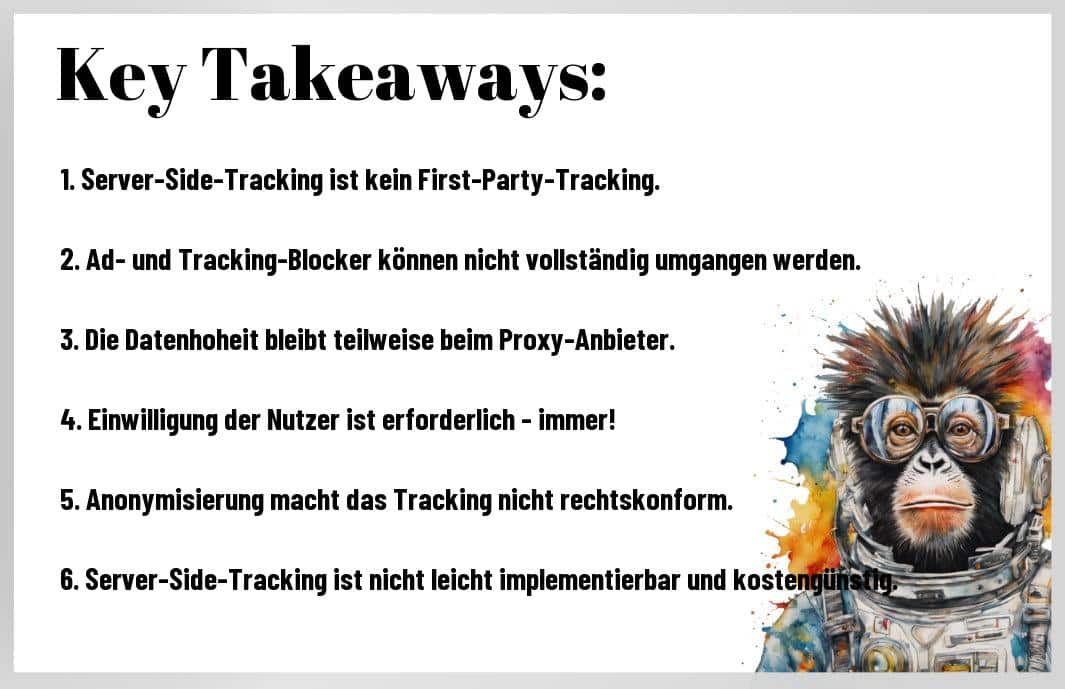
There are a lot of myths surrounding this in the world of data-driven marketing Server & Hosting-Side tracking. It's important to break these myths and get the facts straight. With this Guide The ten best myths surrounding server side tracking are examined and analyzed.
It is crucial to know the truth behind these myths in order to make informed decisions in the area of Servers Side To be able to do tracking.
Myth #1: First-party equation
The first and probably most serious myth about server-side tracking is the false belief that it is “own” intermediate tracking Server. Denn “own” just means that it runs under the company domain, for example data.meinshop.de for meinshop.de. It is usually owned by a third-party provider; the company does not operate the server itself. Often they are Tags Management Systems (TMS)who have such a Proxy function but are operated by a third party. So it's more of a cover-up of this intermediate system. So it looks like first party tracking, but is actually third party tracking.
Myth #2: Blocker bypass
Blocker Bypass – a Trick, which gives hope to many marketers but should be viewed with caution. According to Statista, over 35 percent of internet users today use browser plug-ins such as ad and tracking blockers. But be warned: not all, but only 10 to 20 percent of the blockers are actually bypassed. This can significantly reduce the database and impact your tracking strategy.
The Proxy obfuscation At first glance, server-side tracking may seem to bypass some plugins and even browser-side ITP technologies, but by no means all. Many anti-tracking mechanisms detect server-side tracking just as well as client-side tracking. It is therefore essential to always expect new technological innovations in this area.
Myth #3: Maintaining data sovereignty
A common myth surrounding server-side tracking concerns maintaining data sovereignty. Marketers do have control over what is submitted data to analytics and advertising systems through the proxy configurations, however the tracking provider can access the data and possibly use it for its own purposes. In this case, data sovereignty actually lies with the proxy provider and not with the company itself. It is therefore crucial to pay attention to how the data is ultimately processed to ensure transparency and control.
Learn more about server-side tracking and the top platforms in our article Server side tracking and 9 top platforms.

Myth #4: Waiver of consent
The myth: Some believe that they do not need consent from users to use server side tracking.
The reality: User consent is essential, even with server side tracking.
Why is that? Here are the reasons:
- Data from the end devices: The tracking can read data from the end devices such as the screen resolution.
- Use of cookies: Cookies or similar techniques can be used to recognize users.
- Use of data: The tracking system can use the data for its own purposes.
Even if some aspects of tracking occur on the server side, consent is required, especially if the data is used for the provider's own purposes or is linked across different websites. The consent rate is currently only 17 percent, making it clear that obtaining consent is a challenge.
And finally ... A waiver of consent is not possible with server side tracking. Obtaining consent is crucial in order to comply with legal requirements and to maintain a solid database Basis build up.
Myth #5: Legally compliant anonymization
A common misconception in server-side tracking is the assumption that anonymization is automatically legally compliant. But anonymization according to the requirements of the European Court of Justice (ECJ) is more complicated than many people think. It not only requires the deletion of IP addresses, but also all IDs such as client ID, device ID, user ID and session IDs. Even the timestamp must be transformed or deleted to exclude any traceability to the data subject.
However, reality shows that complete anonymization is often not feasible in practice. Even with careful data deletion, residual information can enable identification. It is therefore crucial not to lull yourself into a false sense of security through superficial anonymization measures.
Marketers need to be aware that incomplete anonymization can not only have legal consequences, but also question the trust of users. It is essential to take the legally compliant anonymization of data seriously and to ensure that appropriate measures are taken Privacy the user is protected.
Myth #6: Data quality assurance
Once acquired, data is in Marketing invaluable. Therefore, ensuring data quality is of utmost importance in order to make informed decisions.
Even more fatal than the reduction of the sample is the distortion of the data due to consent (so-called consent bias). Users are generally very changeable when it comes to agreeing or rejecting cookies - unlike, for example, when voting for political parties: users spontaneously agree to tracking today, but reject it tomorrow Website just as spontaneous.
This inconsistent consent behavior ensures that the database is distorted and campaign success parameters as well as other control-relevant KPIs are arbitrarily over- or underestimated. Server-side tracking doesn't change this.
And even if users do not use ad and tracking blockers or some of them can be circumvented through server side tracking, the problem itself remains: the consent requirement curtails and distorts the database to such an extent that targeted online control becomes impossible.
In addition, complete anonymization, such as privacy advocate they demand, which makes web analytics data completely useless. It is therefore crucial that marketers develop strategies to ensure data quality despite these hurdles.
Myth #7: Unchanged US services

Many online marketers believe that server-side tracking allows the collected data to be easily processed in the USA. The use of US tools also seems to be the case therefore harmless. But this assumption carries some risks.
The main reason is that the GDPR restricts certain procedures, such as Retargeting, prohibited without the express consent of the user. Even with the Data Privacy Framework, which has been in place since July 2023 applies, the legal situation is not clear. Data protection officers could question this adequacy decision in the future.
To learn more about the differences between tracking on the client side and server side, read this article about Client vs. server-side tracking.
Myth #8: Easy implementation
A common myth surrounding server-side tracking is the belief that the Implementation be easy. But the exact opposite is the case! Online marketers face a lot of implementation effort because each data field has to be identified and modified accordingly. From simple From user IDs to complex details such as timestamps or IP anonymization for IPv6 - each component requires careful attention and implementation.
Many online marketers find server-side tracking to be a cost-effective solution because they can choose a seemingly free tracking option. But modern tracking systems are often more cost-effective than the complex proxy solution and do not require complex implementation. Dependence on a proxy provider also entails risks – what happens if they go bankrupt or are bought out? The risk of failures or new implementations can be avoided by relying on established tracking providers.
It is crucial to recognize the reality behind the myth: server-side tracking is not a simple and cost-effective solution, but requires careful planning, implementation and long-term Safety measures. This is the only way tracking can be truly effective and reliable.
Myth #9: Advertising analytics receipt
A common myth about server-side tracking involves the belief that advertising analytics can be improved by using this method. It's important to understand that while server-side tracking offers some benefits, it doesn't necessarily lead to a comprehensive improvement in advertising analytics.
A crucial aspect to consider is the quality of the data generated by server-side tracking. While certain data can be modified and restricted to comply with data protection regulations using this approach, it can also bias the analysis results.
It is essential to verify the relevance and accuracy of the data collected in order to conduct informed advertising analysis. Through careful validation of data sources and implementation of appropriate analysis tools, the effectiveness of advertising analysis can be raised to a higher level.
Marketers should therefore not blindly trust that server-side tracking automatically leads to better advertising analysis, but should critically check the quality and reliability of the data generated. This is the only way to ensure well-founded decision-making in the marketing area.
Myth #10: Cost-effectiveness guarantee
A common myth surrounding server-side tracking is the belief that it offers guaranteed cost-effectiveness. Many companies believe that significant cost savings can be achieved by switching to server-side tracking. However, this is not always the case. Implementing a server-side tracking system can be a significant expense, especially if it needs to be customized and optimized. In addition, ongoing maintenance costs and possible adjustments to new data protection regulations may result in additional expenses.

It's important to understand that while server-side tracking can provide some benefits, it is not a cost-effective solution. Companies should conduct a comprehensive cost-benefit analysisbefore they decide to make the switch.
Caution is advised when it comes to the cost-effectiveness of server-side tracking. Companies should be aware that the supposedly cheaper Alternatives can also be associated with risks and unexpected costs. Careful planning and budgeting are essential to avoid financial surprises.
Server-Side Tracking: The 10 Best Myths
In the world of data-driven marketing surrounding server-side tracking, it is crucial to distinguish between facts and myths. The ten myths listed above show how common misunderstandings and false assumptions are regarding this tracking method. From supposed data sovereignty to cost savings – there are many aspects that companies must critically question when implementing and using server-side tracking. A hybrid solution that cleverly combines client-side and server-side could be one Success be a promising alternative to meet data protection requirements and at the same time create a reliable database for marketing. Ultimately, it is up to companies to take a close look at the realities and best practices of server-side tracking in order to make informed decisions and implement effective marketing strategies.
FAQ
What is Server Side Tracking?
Server-side tracking is a method in which data is not transmitted directly from the browser or app to analytics tools, but rather is routed via a server (proxy).
What is the difference between server-side and client-side tracking?
With server-side tracking, data is forwarded through a proxy server, while with client-side tracking, data is sent directly from the Browser or the app is sent to the analysis tools.
What role does anonymization play in server-side tracking?
Anonymization is important because data is processed in such a way that the Identity the user is protected. This is crucial to comply with data protection regulations.
Is all data protected with server-side tracking?
Although server-side tracking offers some advantages, marketers must ensure that the data is only used for its intended purposes and that user consent is obtained when necessary.
What role do data protection laws play in server-side tracking?
Data protection laws such as the GDPR are also relevant for server-side tracking. Companies must ensure that all regulations are followed in order to protect their users' data protect.





